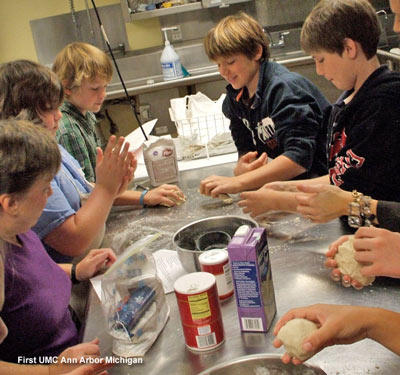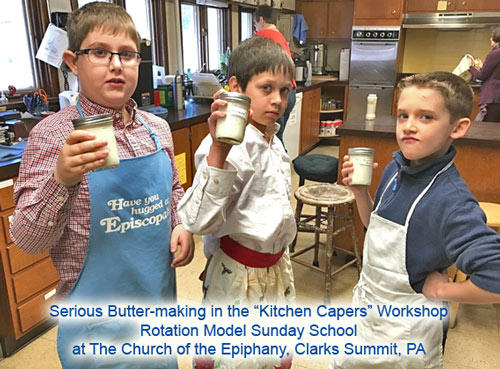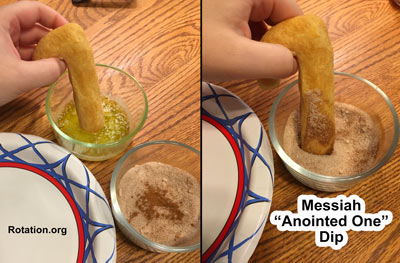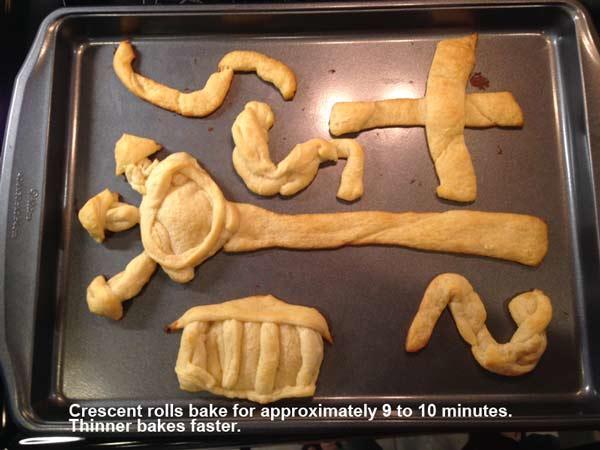This topic continues an older discussion about the Cooking Workshop including extensive posts by Lynn Wood and Neil MacQueen. The following is "something short of a manual" but very helpful.
You are welcome to add to this discussion by replying below.
What is the Cooking Workshop?
The Cooking Workshop is a Bible lesson where the main learning activity is food related in the same way that an art workshop's main learning activity is an art project, or a video workshop's main medium is video.
When we say "cooking" we mean creating something edible by baking, stewing, freezing, sizzling, gel-ing, cutting, mixing, layering, frying, drinking, assembling, toasting, arranging, and of course, EATING!
In the Rotation Model's Cooking Workshop, we don't just "make something to eat after the Bible study." And we don't just "make whale-shaped cookies" for the story of Jonah. Instead, we strive to use any and all aspects of food and its preparation to illustrate and reinforce key concepts in the story, or to tell the story itself. "Making whale-shaped cookies" however tasty and fun, simply doesn't "teach," it only "reminds" the kids of one of the least important parts of that story.
"The Cooking Workshop uses food ingredients, preparation techniques, assembly steps, cooking styles, flavors, shapes, textures, decorating, and scripted "eating" of foods, as well as the making of foods to share to help tell, explain, feel, smell, taste, see, understand and remember the Bible story and its important meanings."

From the Rotation Model's "multiple intelligence" perspective, the use of food to teach a lesson is particularly helpful in enhancing the brain's ability to store and remember content through the association of smell and taste.
- Cooking enhances learning by being hands-on. It focuses their attention towards a goal (and tasty reward).
- Cooking is relaxing and cooperative, helping establish positive feelings between students.
- Cooking can create "associative memories." For example, making and baking flat pita bread (unleavened bread) creates a memory that associates pita with the Exodus story. The next time the student sees or eats pita bread, that memory can be triggered and gets refreshed.
- Cooking and eating can be used to tell a story (Think Passover Seder).
The making of food has a long history in Sunday School. In the Rotation Model, we EMBRACE the medium and make it a regular part of our teaching schedule, rather than, just something for a special occasion. We also try to ELEVATE WHAT WE MAKE and how we eat it to rise above "making whale cookies for Jonah's story." We don't need any more reminders about the whale! What we need are food items that help us remember the MEANING of the story, not simply its characters.
We hit the jackpot when something about the making and the eating and the taste reinforces key concepts and life applications in the story. Our Writing Team's cooking workshop for Luke 2: Shepherds and Angels created a set of "dips" for the kids to mix to teach important ideas in the story. Using the dip pictured above, they learned what "Messiah" means.
Cooking touches our senses in a unique way.
The tastes and smells of food tap into our brain's amazing ability to turn smell and taste into memory and emotion. The smell of your Exodus flatbread and taste of the Fruits of the Spirit pizza create memory anchors in the student's brain for your Bible content.
And because food is such an integral part of daily life, teaching with food/cooking creates memory triggers. For example, making flat pita bread in your Exodus lesson creates a reminder (and refresher) about the Exodus story the next time the student sees or eats pita bread. (This is often called "associative" memory.)
Cooking is extremely hands-on, as well. Rotation Modelers know that getting their students' hands into the dough or dicing carrots, and tasting herbs helps create a rich stew of memories about the lesson content and happy memories directly associated with the content and experience of learning God's Word
Wherever and whenever possible, the students in the Cooking Workshop should be DOING. And where safety is an issue, such as, cutting up fruit, Rotation Modelers look for ways to make their hands-on activities SAFE for the kids to do, rather than doing it for them.
More Cooking Workshop Benefits:
♦ The act of cooking and tasting can create a unique sense of well-being, focus, and anticipation. Cooking and eating helps our student relax, cooperate, listen, and learn.
♦ Following a recipe provides structure which kids readily buy into. The step-by-step pace is perfect for the volunteer who might be a little unsure of their energy level or their ability to maintain classroom discipline. Cooking's familiar techniques and tools put the volunteer at ease. And its outcome is usually delicious and appreciated by all.
♦ Cooking adapts well to different spaces. You can cook in small spaces, borrowed spaces, classrooms, or the church kitchen.
♦ All ages love to cook, and cooking lessons tend to easily adapt to a wide age range.
♦ The tasty results of the Cooking Workshop are easily shared outside the classroom where they can encourage discussion and are much better received than glitter-covered crafts and take-home flyers.

The "Where" of the Cooking Workshop
Many churches hold their cooking workshop in the church kitchen. After all, the kids' parents contribute to that space too, so it shouldn't be off limits. That said, other groups and noise may be an issue, and that means some cooking workshops prepare in class, then "slip quietly into the kitchen" to use the oven. Most Rotation churches discover that the adults love to see the kids using the kitchen, provided they do a great job of cleaning it up.
Some Rotation churches have a spare kitchen, or can safely add an oven and refrigerator to a cooking workshop classroom. Some recipes can be cooked in a microwave, or on a small burner, electric skillet, or induction "Nuwave" portable burner.
Cooking, like Art, can be messy, and good Cooking teachers aren't afraid of this, they're just prepared! If your floor is a concern, bring in a canvas tarp for projects that might have the flour flying. Aprons are a must, and add to the fun. Have plenty of extra tools.
Time and Preparation Considerations
Because of cooking times, many Cooking Workshop lesson plans will put the Bible study in the MIDDLE of the lesson, after preparation, in order for things to bake or stew or congeal in the fridge.
Because some cooking techniques or cooking times take too much of the class time, teachers may prepare certain items in advance. As a rule of thumb, however, it is best to involved the students in as many aspects of cooking as possible.
Creative Cooking Workshop teachers often alter recipes and ingredients to suit their teaching and time needs. They look at ways to get things to cook faster (thinner often helps!).
Safety Issues
Heat, frying, and flames are safety issues, as well as, theological ones! The cooking workshop does not shy away from real cooking, it just does them with the utmost care and preparation, and in an age-appropriate manner. Extra help is a great idea. Watching someone else cook, while good for television, is lousy for learning.
Outfitting your cooking workshop is important to its safety and success. Preparing food involves knives, and they do make cooking safety gloves. All teachers should be reminded of food handling safety procedures.
Food Allergies are a serious concern. The Cooking Workshop teacher should always know who's allergic to what, and if possible, the recipes should be made available to parents ahead of time.
The "Beyond Bread and Cookies" Challenge
Sunday Schools have been making cookie and bread in their lessons for eons. But when you have a Cooking Workshop, you will do more than just one or two cooking projects a year, --you may do 8 to 12! And over several years, how many times can you "bake bread" or "decorate cookies"?? Not many. AS WELL, if you are serious about cooking as a learning/memory technique, you will want to be creative. And that means, limiting the number of "decorated cookie recipes" some teachers will try to pass off as a "cooking workshop."
Because in the Rotation Model we TAKE TIME TO COOK, our recipes and approaches can be more complex than traditional approaches which treated the cooking project as a "fun activity" at the end of the lesson.
Think BEYOND BREAD, BEYOND COOKIES and CUPCAKES. Those are nice things that work when you don't really do much cooking in your Sunday. But in Rotation, you not only NEED to add more types of preparation, food, and cooking styles, you WANT TO !
In the cooking workshop, you can make stews, pies, pizzas, salads, and real deserts. You can bake "maps" of the story or landscape with food.
Here's a sheet of baked "story parts" which the students create and bake, then assemble, and label to create an edible Paul/Damascus Road Map. (From Cooking Workshop lesson in the Writing Team's Paul and the Bright Light Lesson Set.)
Keep reading for more good ideas...
Cooking Story Props
Traditional cooking in Sunday School involves "making something from the story." For example, you're studying about the Shepherds and Angels, so you make shepherd and angel cookies. That's an example of "cooking story props." Many in the Cooking Workshop consider that a "back-up plan" and will first consider how their cooking project can tell a story, rather than, just one prop-part of the story.
In other words, instead of making "sheep cookies" for Psalm 23, you might make a desert PIE that features various colors and fruits arranged to depict "still waters" and "dark valleys." Read on...
Cooking and Eating as Storytelling
In Cooking as Storytelling, the teacher walks the students through the assembly of ingredients as they hold up each ingredient and ask about how it represents an important idea or character in the story. Ingredients can represent ideas in a story, or characters, props, and meanings. The preparation and cooking technique(s) can also represent ideas in the story, characters, or meanings. Covering, kneeding, mixing, layering... The order in which you add ingredients or layer a pie, or plate the food can teach the order of the story.
Certain ingredients can represent props in the story. For example, in the "humble Samaritan's pie" you can have the students slice and add two slices of sour apple to represent the priest and Levi. You can slice a golden apple to represent the money the Samaritan gave from his purse to the innkeeper. The holes on the top of the pie can be a message from the story.
Cooking as Storytelling often takes a lot of thought on the part of the teacher. They will alter recipes to meet their teaching objectives and time constraints. Rename or substitute ingredients. Add food coloring, or suggest a particular 'shape" of an ingredient.
"Taste and See," "Eating to Reinforce,"
Eating in a Ritual of Remembering
The Passover Seder meal is a great example of using specially prepared foods to help us recall the story of the Exodus. The meal is scripted with "do this, say that" elements. Tastes and appearances of various special foods are memory devices for different parts of the story.
The Rotation.org Writing Team has taken this "ritual of eating" a step further and created Cooking lessons that involve both the making of food and the scripted eating of that food as part of the lesson narrative. For example, the Cooking Workshop for "Jesus Goes to the Cross" has the kids assemble and participate in a "Cross Seder" -- with various food representing different parts of the Mark 15 narrative. We've also scripted a "Shepherds and Angels" meaningful meal using shepherds crooks the kids bake and several "DIPS" the kids mix and dip the crooks into at various parts of the storytelling. (Reminder: WT lessons are open to supporting members only.)
Are the Cooking and Storytelling Workshops the Same Thing?
The question has been raised here at Rotation.org!
In one script, a woman dressed as Sarah told their story about the 3 angels who told her she would be the mother of a great nation, ....while kneading and rolling out bread. Then she invited the kids to make "journey cakes" with them, and cooked them on a "hot stone" (an upside down wok). As the cakes baked, she talked about the difficult journey she had been on, and how she trusted God to sustain her.
Perhaps the Cooking Workshop is really a different way to do the SCIENCE Workshop. Both involved ingredients, mixing/preparing, and enjoying the outcome. These "object lesson" -centered activities are the FRAMEWORK upon which the teacher hangs the concepts of the lesson, makes the connections, and drives home the point of the passage.
Cooking to Share
Like all food, sharing what you cook is a great way for kids to feel connected to others and share the story behind their creation. They may take home a shepherd's pie for their family to sample, or they may bake friendship cookies for some of the older "Naomis" in their congregation.
A lesson in the the Esther story's cooking workshop suggests making "Challah Bread" to share because that is a tradition Purim activity.
Cooking to Eat & Engage in a Ritual
The Passover Seder Meal is a good example of this style of Cooking Workshop lesson. Students prepare different parts of a meal, each of which help tell a story, then the class assembles the elements and is led through a "ritual" way of eating their creation. This doesn't just have to be for a Last Supper Rotation! You can imagine, for example, the meal Jesus had at Zaccheus' house that day (shortbread? mashed potatos in the shape of a tree we use to "look" Jesus) and what they talked about, then write it as a "Zaccheus Seder". In this approach, you have more freedom to choose foods and can assign meaning to all sorts of foods that fit your preparation schedule and needs.
Food as Mission
Some Cooking Workshops will cook foods that relate to various mission projects or places in the world their church is engaged. For example, if they are studying the Good Samaritan, they may assemble "hygiene kits" for a homeless shelter that include candy and trail mix. Or if they support a missionary in the Congo, they may make a sweet orange and date dessert to share with others.
Food as Art
Kids love to build pictures with mashed potatoes, and add veggies and other items to make scenes of the story they are learning. A Bible hero fruit-on-a-stick puppet created for an impromptu puppet show in the cooking workshop can be a lot of fun. Just remember that most of the time, the food should be eaten and not wasted.
Food as a Science Demonstration
Food can expand, collapse, melt, change color. Ingredients, such as baking soda, cause chemical reactions to occur. All these 'food actions' can be metaphors for something in the story, or our behavior.
Cooking Workshop teachers are adept at ADAPTING recipes they see in various sources for Sunday School use.
Family magazine and blogs, for example, are great sources of kid-friendly recipes. In the cooking workshop lessons here at rotation.org, you'll see this done quite a bit.
If the story is right, your cooking workshop could be about drinking, thirst, cup, water, grapes.
Cooking can also be about planting and harvesting.
Some cooking workshops have taken to SOWING & GROWING their own food.
Because the Cooking Workshop makes cooking and eating a REGULAR part of your curriculum, you can explore many possibilities and approaches.






